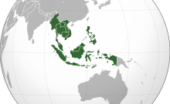Molly Minturn - My family is heartbroken to share that my father died in surgery on Monday, Feb. 10. It…
Forests and Deforestation 2021-
Written by Diana Thebaud Nicholson // March 13, 2024 // Biodiversity, Natural resources // Comments Off on Forests and Deforestation 2021-
The world’s 3 trillion trees, mapped
Which Countries Have the Most Trees?
Why forests need fires, insects and diseases
Seven times size of Manhattan: the African tree-planting project making a difference
Thousands of farmers have been persuaded by TREES scheme to replace barren monocultures with biodiverse forest gardens
by Jonathan Watts
In a world of monoculture cash crops, an innovative African project is persuading farmers to plant biodiverse forest gardens that feed the family, protect the soil and expand tree cover.
Could Trees for the Future (TREES) be a rare example of a mass reforestation campaign that actually works? The United Nations Environment Programme (UNEP) certainly thinks so and last month awarded it the status of World Restoration Flagship.
Since it was founded in 2015, the programme has planted tens of millions of trees each year in nine countries ranging from Senegal and Mali to Tanzania and Kenya. In less than 10 years, it has reportedly restored a combined area of more than 41,000 hectares, which is about seven times the size of Manhattan.
15 February
Ill-judged tree planting in Africa threatens ecosystems, scientists warn
Research reveals area size of France is under threat by restoration projects taking place in unsuitable landscapes
Misguided tree-planting projects are threatening crucial ecosystems across Africa, scientists have warned.
Research has revealed that an area the size of France is threatened by forest restoration initiatives that are taking place in inappropriate landscapes.
One project in particular, the African Forest Landscape Restoration Initiative, aims to plant trees across 100m hectares (247m acres) of land by 2030. Scientists have warned that the scheme plans to plant trees in non-forest ecosystems such as savannahs and grasslands, potentially disrupting or destroying intact ecosystems.
The research found that 52% of tree-planting projects in Africa are occurring in savannahs, with almost 60% using non-native tree species, which also brings the risk of introducing invasive species.
The researchers say the misclassification of grassy ecosystems including savannahs as “forests” could lead to misplaced reforestation and destruction of these ancient grasslands.
10 February
‘It was total panic – with black smoke, falling fireballs and tongues of flame’: the terror of Chile’s wildfires
A long drought followed by exceptional heat and wind brought deadly blazes that ripped with devastating speed through the coastal town of Viña del Mar
Chile has seasonal wildfires every year, but the velocity and deadliness of this blaze were unprecedented. More than 130 people have died, according to official figures, and at least 370 are reportedly missing in Viña del Mar. The country’s forensic medical service is using DNA testing to identify human remains.
Chile’s president, Gabriel Boric, has described the deadly blaze as “the worst fire in an urban area in the last 30 years”, calling it the “biggest human tragedy” since an 8.8-magnitude earthquake in 2010, in which more than 500 people died.
12 January
Can Planting Trees Solve the Climate Crisis? (podcast)
(CrowdScience BBC) Can we plant enough trees to soak up all the extra carbon we are putting into the atmosphere?
The quest to find answers takes us to a remote re-forestation project in the Carpathian Mountains in Romania which could be a model for other projects looking to tackle the climate crisis through reforestation.
We speak to experts to find out how much tree planting and reforestation can do in helping combat the climate crisis.
Carbon offsets are helping protect B.C.’s Great Bear Rainforest. But is that sustainable?
Coastal First Nations communities using traditional knowledge to manage Great Bear Rainforest
(CBC radio) The Guardian Watchmen is an Indigenous-led conservation program in the Great Bear Rainforest, a 6.4-million-hectare swath of snow-capped mountains and towering conifers that stretches from central B.C. to the Alaskan panhandle.
Watchmen programs…operate in seven communities along the coast and on Haida Gwaii, employing some 150 local Indigenous people. …it’s an important shift from the traditional park ranger model.
Unlike park rangers, however, whose salaries are paid for with tax dollars, Guardian Watchmen are partially funded by an unusual source: carbon offsets.
Offsets are a way to “cancel out” greenhouse gases that are spewed into the atmosphere elsewhere. They work by letting emitters (individuals, corporations or governments) fund and take credit for emissions reductions from a project done by another party.
2023
The Year that Proved Why Forestry Matters
The Forest Products Association of Canada
The year 2023 is one that will long be remembered for Canada’s worst-ever fire season. It was also the year that Canada’s affordable housing crisis came into full view, with urgency for many policymakers across the country.
These issues impacted millions of Canadians in 2023 – and renewed a critical dialogue about the importance of more actively managing our forests and doing more with Canadian grown resources.
The record-breaking wildfires that ravaged more than 18 million hectares of land showed how our forests are being hit by hotter temperatures and drier conditions. The need for a crisis-level response similar to that being taken in the United States is clear, and more active management such as thinning and prescribed burns will be essential if we want to avoid more devastating fire seasons.
At the same time, the housing and affordability crisis underscored the need to get back to basics so that Canadian families can afford shelter, food, and other necessities. We need an estimated 5.8 million additional housing units by 2030 to restore affordability, and we must do more to support business conditions so we can attract investment to produce and build these homes.
24 December
America Lost Its One Perfect Tree
Lumber, shelter, delicious nuts—there was nothing the American chestnut couldn’t provide. …in modern American life, chestnuts are almost entirely absent. In the first half of the 20th century, a fungal disease called blight, inadvertently imported from Asia on trade ships, wiped out nearly all of the trees
By Katherine J. Wu
(The Atlantic) Across the Northeast, forests are haunted by the ghosts of American giants. A little more than a century ago, these woods brimmed with American chestnuts—stately Goliaths that could grow as high as 130 feet tall and more than 10 feet wide. Nicknamed “the redwoods of the East,” some 4 billion American chestnuts dotted the United States’ eastern flank, stretching from the misty coasts of Maine down into the thick humidity of Appalachia.
The American chestnut was, as the writer Susan Freinkel noted in her 2009 book, “a perfect tree.” Its wood housed birds and mammals; its leaves infused the soil with minerals; its flowers sated honeybees that would ferry pollen out to nearby trees. In the autumn, its branches would bend under the weight of nubby grape-size nuts. When they dropped to the forest floor, they’d nourish raccoons, bears, turkey, and deer. For generations, Indigenous people feasted on the nuts, split the wood for kindling, and laced the leaves into their medicine. Later on, European settlers, too, introduced the nuts into their recipes and orchards, and eventually learned to incorporate the trees’ sturdy, rot-resistant wood into fence posts, telephone poles, and railroad ties. … It made up the cribs that newborn babies were placed into; it shored up the coffins that bodies were laid to rest inside.
8 December
How Much Can Forests Fight Climate Change? A Sensor in Space Has Answers.
A new NASA program is helping researchers more accurately calculate how much planet-warming carbon protected areas are storing. It’s a lot.
(NYT) Over the last century, governments around the world have drawn boundaries to shield thousands of the world’s most valuable ecosystems from destruction, from the forests of Borneo and the Amazon to the savannas of Africa.
These protected areas have offered lifelines to species threatened with extinction, supported the ways of life for many traditional communities and safeguarded the water supplies of cities.
But reserves are facing increasing pressure, their boundaries largely disregarded as people cut down trees and push deeper into the ecosystems set aside for protection.
Now, high in orbit, a new way of seeing forests is making it clear that, even when under assault, protected areas can still be a crucial buffer against climate change. Scientists are using laser technology to gauge the biomass of forests all around the world, which lets them calculate how much planet-warming carbon the trees are keeping out of Earth’s atmosphere.
4 December
How Mounting Demand for Rubber Is Driving Tropical Forest Loss
(Yale environment 360) The growing market for rubber is a major, but largely overlooked, cause of tropical deforestation, new analysis shows.
The elephants are gone. The trees are logged out. The Beng Per Wildlife Sanctuary in central Cambodia is largely destroyed, after being handed over by the government to a politically well-connected local plantation company to grow rubber.
In West Africa, the Luxembourg-based plantations giant Socfin has been accused in recent weeks of deforestation and displacing Indigenous people around its rubber plantations in Nigeria and Ghana.
Meanwhile, on the heavily deforested Indonesian island of Sumatra, tire multinational Michelin and a local forestry company raised $95 million worth of green investment bonds on the promise that they would reforest bare land with rubber trees. But the NGO Mighty Earth has found that much of the plantation went ahead on land from which natural forest had been removed as recently as a few months before by a subsidiary of the local company.
These are just three examples among hundreds of one of the biggest, but least discussed, causes of tropical deforestation. The spread of rubber plantations is driven primarily by our demand for more than 2 billion new tires each year.
13 November
Let forests grow old to store huge volume of carbon – study
Report says cutting emissions should still be key priority as it cautions against mass monoculture tree-planting
(The Guardian) Forest conservation and restoration could make a major contribution to tackling the climate crisis as long as greenhouse gas emissions are slashed, according to a study.
By allowing existing trees to grow old in healthy ecosystems and restoring degraded areas, scientists say 226 gigatonnes of carbon could be sequestered, equivalent to nearly 50 years of US emissions for 2022. But they caution that mass monoculture tree-planting and offsetting will not help forests realise their potential.
Humans have cleared about half of Earth’s forests and continue to destroy places such as the Amazon rainforest and the Congo basin that play crucial roles in regulating the planet’s atmosphere.
The research, published on Monday in the journal Nature as part of a collaboration between hundreds of leading forest ecologists, estimates that outside of urban agricultural areas in regions with low human footprints where forests naturally exist, they could draw down large amounts of carbon.
Integrated global assessment of the natural forest carbon potential
Although forests cannot be a substitute for emissions reductions, our results support the idea2,3,9 that the conservation, restoration and sustainable management of diverse forests offer valuable contributions to meeting global climate and biodiversity targets.
11 November
Can goats and sheep stop wildfires? This shepherdess is rallying the flock
Ruminants have become an increasingly common sight on land primed to burn across the US west, and Bush says there’s been a growing demand for her services. She and her team have put their hundreds-strong herds to work chewing down parched plants for landowners, government agencies, housing developments and detention centers.
The ancient practice is taking on new significance in an era of climate uncertainty – and there’s lots of work to go around.
January 2019
California town sets up ‘goat fund me’ page to finance four-legged firefighters
Nevada City is seeking to raise $30,000 to acquire goats to munch through acres of vegetation that could fuel wildfires
8 November
Scientists urge Canada to take action to stop degradation of previously undisturbed forests
A letter signed by several prominent Canadian and American climate and forest scientists calls on the government to help global policies intended to curb industrial expansion into old-growth and primary forests.
(Canadian Press via Globe & Mail)It comes as Canada moves to draft its own definition of forest degradation after the European Union passed a law earlier this year intended to limit the availability of products that contribute to deforestation and degradation.
Environmental groups have called out Canada’s efforts to lobby the EU to drop references to forest degradation from the law.
While Canada has often boasted about its low rate of deforestation – when forest land is converted for another use – the letter places attention on the degradation associated with logging old-growth and primary forests previously undisturbed by large-scale industrial activity.
29 October
‘Killing’ trees: How true environmental protection requires a revolution in how we talk about, and with, our forests
Deforestation is a global problem with grave consequences for biodiversity and planetary health.
, Associate Professor, Department of Film, Faculty of Media, Art, and Performance, University of Regina
(The Conversation) Which came first, the acorn or the oak? A more important question is which came first: our words for trees, or our understandings of what trees are?
Human discourse around trees both shapes and is shaped by our education, beliefs, experience and relationships with trees. Simply put, how we speak about trees matters.
Ten years ago, I appreciated trees alongside concern for the health of our planet, but did not consider the ways we speak about trees or their profound intricacies. Then, through an unexpected turn in my research, I became more aware of trees’ relationships, sentience, intelligence and interconnections with their environments as home and community.
As we near the anniversary of last year’s UN Convention on Biological Diversity in Montréal, it is apparent that our collective tree discourse needs to fundamentally shift in order to reconnect with the integrity, interconnectivity and protection of all ecosystems called for in the Kunming-Montréal Global Biodiversity Framework.
2022
19 October
Wildfires reshape forests and change the behavior of animals that live there
Taylor Ganz, Ph.D., wildlife ecologist, Prugh Lab, School of Environmental and Forest Sciences, University of Washington
(The Conversation) In the arid American West, wildfires now define summer. Recent years have seen some of the worst wildfires in recorded history. Climate change, the loss of Indigenous burning practices and a century of fire suppression are increasing the risk of larger, hotter and more frequent wildfires.
I’m a wildlife ecologist studying how the presence of wolves and other predators is affecting deer and elk in Washington state. I’m particularly interested in understanding how these species interact in changing landscapes.
20 July
‘In 10 years, we might not have forests’: DRC struggles to halt charcoal trade – a photo essay
Projects involving the Batwa and other marginalised communities offer alternative fuel and income, but can only ever be a small part of a wider drive to stop deforestation
(The Guardian) The Batwa people have lived in the region for millennia. Since the 1970s, they have been caught up in a cycle of violence in the forests, which is home to the endangered Grauer’s, or eastern lowland, gorilla. The tensions deepened in recent weeks after a German-funded investigation into alleged massacres in the park was accused of covering up accounts of rapes and killings of Batwa people, formerly known as Pygmies, by park rangers.
The rainforest of the Congo River basin covers 178m hectares (440m acres) across six countries. It absorbs about 4% of global annual carbon emissions, sustains rainfall as far away as Egypt, and is home to 80 million people – and a vast spectrum of rare animals, insects and flora. Its preservation is deemed key in the fight against global heating.
But DRC has one of the world’s highest rates of deforestation, losing 490,000 hectares (1.2m acres) of primary rainforest in 2020, according to Global Forest Watch. Unlike in the Amazon, where industrial-scale logging is mostly responsible, in DRC small-scale charcoal production and slash and burn agriculture drive deforestation; about 90% of forest loss between 2000 and 2014 was due to smallholder agriculture, according to a 2018 report in Science Advances. (Congo Basin forest loss dominated by increasing smallholder clearing)
18 June
The Amazon rainforest is disappearing quickly — and threatening Indigenous people who live there
Women and children, the main victims of deforestation
(The Conversation) A recent United Nations report reveals a strong correlation between worsening climate change and deteriorating human rights around the world.
Deforestation disproportionately affects Indigenous communities, especially women and children. It increases the pressure already placed on women to feed their children and families, while limiting their access to essential goods, including medicine.
Indeed, the health of these communities depends on access to natural medicinal products found in biodiversity. The Amazon is a major reservoir of substances used in the manufacture of several pharmaceutical products available on the South American continent.
Nearly 80 per cent of the population in developing countries relies on natural medicinal products for their primary health care. In the majority of communities, it is also women who are responsible for cultivating the land and providing transportation and water treatment.
2021
26 November
Sources: Brazil withheld deforestation data ’til COP26’s end
By DÉBORA ÁLVARESN
(AP) — Brazil’s President Jair Bolsonaro and Environment Minister Joaquim Leite both knew the Amazon region’s annual deforestation rate had surged before the U.N. climate talks in Glasgow, but kept results quiet to avoid hampering negotiations, according to three Cabinet ministers who spoke to The Associated Press on condition of anonymity.
Data from the National Institute for Space Research’s Prodes monitoring system released Thursday showed the Amazon lost 13,235 square kilometers (5,110 square miles) of rainforest in the 12-month reference period from August 2020 to July 2021. That’s up 22% from the prior 12-month period and the worst in 15 years.
The three ministers as well as a coordinator at the space institute that compiles the data, all of whom spoke with the AP on condition of anonymity due to concern about reprisals, said the annual deforestation report was available on the government’s information system before talks in Glasgow began on Oct 31.
17 November
This article was produced in partnership with the Pulitzer Center’s Rainforest Investigations Network.
How Americans’ Appetite for Leather in Luxury SUVs Worsens Amazon Deforestation
An examination of Brazil’s immense tannery industry shows how hides from illegally deforested ranches can easily reach the global marketplace. In the United States, much of the demand for Brazilian leather comes from automakers.
A New York Times investigation into Brazil’s rapidly expanding slaughterhouse industry — a business that sells not only beef to the world, but tons of leather annually to major companies in the United States and elsewhere — has identified loopholes in its monitoring systems that allow hides from cattle kept on illegally deforested Amazon land to flow undetected through Brazil’s tanneries and on to buyers worldwide.
2 November
COP26: World leaders promise to end deforestation by 2030
More than 100 world leaders have promised to end and reverse deforestation by 2030, in the COP26 climate summit’s first major deal.
Brazil – where stretches of the Amazon rainforest have been cut down – was among the signatories on Tuesday.
The pledge includes almost £14bn ($19.2bn) of public and private funds.
Experts welcomed the move, but warned a previous deal in 2014 had “failed to slow deforestation at all” and commitments needed to be delivered on.
Felling trees contributes to climate change because it depletes forests that absorb vast amounts of the warming gas CO2.
UK Prime Minister Boris Johnson, who is hosting the global meeting in Glasgow, said “more leaders than ever before” – a total of 110 – had made the “landmark” commitment.
Suzanne Simard on the secret societies of trees
(CBC The Current) Suzanne Simard has spent a lifetime trying to understand the secret societies of trees — how they work together, help each other and even how they speak to one another. Simard is a professor of forest ecology at the University of British Columbia. She tells us about her work, what it means for old-growth forests amid a climate emergency and her new book Finding the Mother Tree.
8 May
Finding the Mother Tree by Suzanne Simard review – a journey of passion and introspection
A root-and-branch study of the network that sustains our forests shows how all life is interconnected
6 May 2021
Suzanne Simard Changed How the World Sees Trees The pathbreaking ecologist on interspecies collaboration, tree sentience, and nature’s resilience.
By Robert Moor
(New York) Suzanne Simard has given her life to the study of trees. She sweated for them. Bled for them. Damn near died for them — once at the claws of a grizzly, and once from the invisible clutch of cancer. (Working with toxic herbicides and radioactive isotopes in the course of her research likely contributed to her breast cancer, which resulted in a double mastectomy.) But Simard’s sacrifices as a forest ecologist have paid off. Her work with herbicides uncovered the fact that denuding tree farms doesn’t help them grow faster — a finding that overturned the forestry industry’s prevailing logic for half a century. Later, upending basic Darwinian logic, she showed conclusively that different trees — and even different tree species — are involved in a constant exchange of resources and information via underground fungal networks, known technically as mycorrhizae and popularly as the Wood Wide Web.



